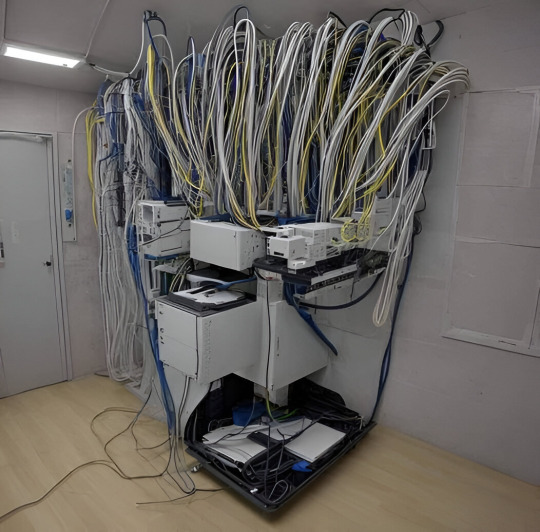#computer server
Explore tagged Tumblr posts
Text
Thinking of making my own computer server ik you can do that with your laptop but I gotta figure out how
Any help is appreciated 👍
0 notes
Text

1K notes
·
View notes
Text

Administrator privilege revoked.
you can't convince me Colin wasn't bashing Freddie's servers in with a crowbar while in his pjs, it was like four am
#cough the implications of there being no blood in the server room is insane#even his hand was pristine#how.#how does a computer dismember a it guy?#with wires ofc!!#tmagp#the magnus protocol#tmagp fanart#tmagp 31#tmagp spoilers#colin becher#colin tmagp#tma#cw blood#floors scribbles#my art#sal dont look
2K notes
·
View notes
Text

Priests and monks blessing server rooms and sprinkling holy water on computer systems as a way to prevent them from ever shutting down
More at source
5K notes
·
View notes
Text
I took a decommissioned rackmount 1u server to the hacker meetup because someone last month asked if anyone knew where to get a server cheap and I was like "you get a server cheap from me please take it" but when I brought it to the meetup I didn't realize that she'd be taking the train home so I offered to drive it back to her place between locations at the meeting but she had moved so that wasn't really feasible but then I remembered that I had an Ikea shopping bag in my car and it turns out that a Dell T430 will totally kinda mostly fit in an Ikea shopping bag and can then be carried on a train.
#the woman I gave the server to is also very very petite#so there was this very small lady carrying a very large computer in a very large bag#and it was overall a delightful experience
523 notes
·
View notes
Text













663 notes
·
View notes
Text
(prev...?)



fork bomb
#oh yeah more computer science gabv1el#what do you mean computer science gabv1el is not a real thing#anyways this happened because of that irl lab server fork bomb post#also gabriel holding a fork hehe#i mean after layer 6 he's not that holy anymore so he can do some devil related stuff#ultrakill#ultrakill v1#ultrakill gabriel#gabv1el#(yes)#my art
296 notes
·
View notes
Text

this is so silly lol
#DONT ASK ME IF I KNOW WHAT COMPUTER SERVERS LOOK LIKE I CLEARLY DONT#also im sure he never bled at any point but i needed some sort of indicator lol#cw blood#cw body horror#cus of his hand#tmagp spoilers#tmagp#tmagp 31#the magnus protocol#colin becher#tmagp fanart#tmagp season 2#tmagp colin#my art
277 notes
·
View notes
Text

Server cable management.
611 notes
·
View notes
Text

hi tptm-ers. use with freedom...
#tptm#the post traumatic manifesto#the post-traumatic manifesto#cactertalk#i geuss... it's not really art#i saw a post of someone else's tptm stamps and remembered i've been updating this bad boy for. a while now#i have a lot of stamps (mostly just gifs from mvs i like) that stay on my computer + discord server because i plan on moving them to my +#own website one day... WHENEVER THE FUCK i'll finish that thing#point is i enjoy making them. please use this one in whatever way you want#also i'll probably update it when girl 9 and the last one finally come out
265 notes
·
View notes
Text
How to Create an Effective Server Maintenance Schedule?
Creating an effective server maintenance schedule is crucial for ensuring the smooth operation of your IT infrastructure. A well-maintained server reduces downtime, improves performance, and enhances security. This guide will help you understand the essential steps to create a server maintenance schedule that keeps your systems running efficiently.
Why Server Maintenance is Important
Server maintenance is essential for several reasons:
Prevents Downtime: Regular checks and updates prevent unexpected server failures.
Enhances Security: Keeping software up-to-date protects against vulnerabilities.
Improves Performance: Regular maintenance ensures your server runs efficiently.
Extends Server Life: Proper care prolongs the lifespan of your server hardware and software.
Steps to Create an Effective Server Maintenance Schedule
1. Assess Your Server Needs
Start by understanding the specific needs of your server. Different servers (web servers, database servers, etc.) have different maintenance requirements. Identify the critical components that need regular attention.
2. Schedule Regular Backups
Ensure that all data is backed up regularly. Schedule daily, weekly, or monthly backups depending on the importance of the data. Use automated tools to streamline this process and verify that backups are successful.
3. Perform Software Updates
Regularly update your server’s operating system, applications, and firmware. These updates often include security patches and performance improvements. Schedule updates during off-peak hours to minimize disruption.
4. Monitor Server Performance
Set up monitoring tools to keep track of server performance metrics such as CPU usage, memory usage, and disk space. Monitoring helps you identify and resolve issues before they become critical.
5. Clean and Optimize Storage
Regularly clean up unnecessary files and logs. Optimize your storage by defragmenting disks and reorganizing data. This helps in improving access speed and overall performance.
6. Check Security Logs
Regularly review security logs to identify any unusual activity or potential security breaches. Implement automated alerts for critical security events.
7. Test Backup and Recovery
Periodically test your backup and recovery procedures to ensure data can be restored quickly in case of a failure. This step is crucial for disaster recovery planning.
8. Plan for Hardware Maintenance
Schedule regular hardware inspections and maintenance. Check for wear and tear on physical components such as hard drives, fans, and power supplies. Replace faulty hardware promptly to avoid unexpected failures.
9. Document Maintenance Procedures
Document all maintenance tasks and procedures. This ensures consistency and provides a reference for troubleshooting. Keep logs of all maintenance activities and update them regularly.
10. Train Your Team
Ensure your IT staff is trained on server maintenance best practices. Regular training sessions help keep your team updated on the latest maintenance techniques and tools.
Tips for a Successful Maintenance Schedule
Automate Where Possible: Use automated tools for backups, updates, and monitoring to reduce manual effort and minimize human error.
Regular Reviews: Periodically review and update your maintenance schedule to adapt to changing needs and technologies.
Communication: Inform all relevant stakeholders about maintenance schedules to avoid surprises and plan for downtime.
Conclusion
Creating an effective server maintenance schedule is a proactive step towards ensuring the reliability and performance of your IT infrastructure. By following these steps and regularly reviewing your maintenance practices, you can prevent downtime, enhance security, and prolong the life of your servers. Start implementing these strategies today to keep your servers running smoothly and efficiently. Visit Netseg.me for more details.
0 notes
Text
tr!tubbo animatic upon ye, It's not as finished/polished as I wanted it to be but if I spent more time on it, it would never have gotten uploaded
youtube link below
youtube
#art#artists on tumblr#my art#digital art#drawing#tubbo#the realm#the realm smp#the realm fanart#tr!tubbo#tr!aimsey#tr!seapeekay#tr!bad#tr!ros#tr!scott#rory does shit#animatic#i REALLY wanted to get the first half of the song in#but i needed screenshots from the server map for it and my computer can't run the map#wish it didn't start as abrupt but no one was gonna sit through 31 seconds of nothing#generally like the idea but im not proud of the execution#Youtube
87 notes
·
View notes
Text

2K notes
·
View notes
Text
Rubius: [Switches to his "Angel" skin, ready to cause problems] Ehehe... Ok, perfect.
Rubius: ¡Hola! 😇
Phil:
Rubius: ...¿Hola? ¡Hola! Hello?
Phil:
Rubius: ...Is he stupid or something? 😒

#Rubius#Philza#QSMP#Phil#Rubius: Hello!#Phil's easily distracted atheist ass: 🔇#April 5 2023#Timestamp: 6h 35m#Rubius' POV – Phil was not streaming at the time so no timestamps for him#Edited#Subtitles#Translated#Every day of my life I mourn what could have been if Rubius had stayed on the server longer#Anyways if you see a dip in the video quality from HD to like 760 it's because the first 80% is my clip I made ages ago#and then the rest I had to pull up from the archived VOD#''Why can't all archived VODs be 1080 HD quality?'' I say knowing damn well my own computer is ready to explode#because of all the VODs I've saved in HD quality#Thanks for checking my translations Bell!
124 notes
·
View notes
Text
「Demo WIP」 Can y'all watch my plant real quick? 🍈
#Y'all ever plant a Filipino cantaloupe and it just randomly grows into a giant human overnight? No??? Just me???????#Anyways!! Don't be fooled this is literally just reskinned Ren Bot from Discord lmao#The RenPy to Pycord back to RenPy pipeline is real#Will I ever come back to this project?? Mayhaps not.... We'll see#My plan is to turn it into a comfy window game that you can have running in the background#It'll play some lo-fi beats and let you feed/pet Sage every so often to level their affection meters#Higher affection will yield better responses + maybe an outfit/scenery change#You can also talk to them the same way you talk to Ren Bot (for those familiar with him in the Discord server)#So you could like.... talk about your day and Sage will listen ^^#I also wanna add a dynamic background that corresponds to your local computer time.... If I feel ambitious enough hehe#But for now?? lazy 2 hour sketches featuring MAD inspo from the FFXIV dancer gear bghsdjgd#game dev#visual novel#maybe???? is she??#clicker game? pet sim?? knock-off honeydew Tamagotchi?? we just don't know#queue.#to be tagged later
291 notes
·
View notes